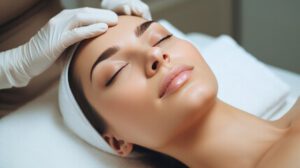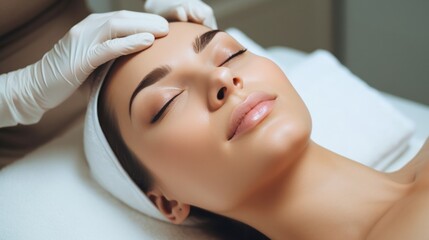House of Aesthetix is the fusion of beauty and healthcare. It includes procedures such as filling, botox, dermapen, and hair removal.
Medical aesthetics has become a mainstream industry that continues to destigmatize cosmetic procedures. This has fueled the rise of medspas and beauty bars. These facilities offer more comfortable and less sterile environments for patients to complete their procedures.

The medical aesthetics industry is a beautiful little niche that sits squarely between beauty treatments and plastic surgery. It’s a world of stunning tweakments, administered by highly skilled doctors, nurses and dentists, that can dramatically alter your appearance.
Aesthetic medicine has been around for centuries, but it’s only in the last couple of decades that the world has truly embraced its potential. Thanks to advances in medical technology and science, it’s now possible to make more dramatic cosmetic changes than ever before.
These changes can be as minor as adding a bit of definition to your jawline or as major as a facelift. But it’s important to remember that these treatments are still medical procedures and must be performed by a qualified physician. The goal is to help you feel more confident and comfortable with your appearance without having to go under the knife.
As a result, more and more people are turning to medical aesthetics to improve their looks. And this is only going to continue to grow.
There’s a lot to love about medical aesthetics, from the fusion of beauty and healthcare, to the fact that it’s non-invasive. But there are also a few drawbacks. One of the biggest is that medical aesthetics can be prone to charlatans and practitioners who use unethical practices or make unproven claims. This is especially true in an era where demand for cosmetic treatments is high and competition is stiff.
In order to protect consumers and maintain a high level of professionalism, medical aesthetics manufacturers need to adopt new business models that allow them to compete in the modern marketplace. This could mean partnering with another industry, like travel, to market their products or creating a new type of subscription service that provides customers with proactive and personalized care.
The future is bright for medical aesthetics, but it’s important that providers and manufacturers adopt strategies that take advantage of the new opportunities in the marketplace. By embracing innovation and analyzing the business models of other industries that operate within a similar regulatory framework, they can create their own successful niche in the medical beauty industry.
Medical aesthetics is a popular option for people who want to improve their appearance without going through surgery. It offers a variety of cosmetic procedures that are safe, effective, and affordable. Some of the most common treatments include injectables like BOTOX, dermal fillers, and laser therapy. These treatments can make you look younger and more refreshed. They also help reduce the appearance of fine lines and wrinkles. However, it is important to note that these treatments are not a substitute for a good skincare routine.
Many people are interested in medical aesthetics because it can help them feel more confident about their appearance. The procedures can be done quickly and with minimal discomfort. They can also be used to treat conditions such as psoriasis and acne. They can also be used to enhance the appearance of the lips and cheeks.
There are several reasons why medical aesthetics is growing so rapidly. It has a huge potential market, significant investment from private equity funds and manufacturers, and a strong track record of resilience following economic downturns. It also has a lower barrier to entry than some other consumer industries, and it is easy to start a practice with little capital.
The latest trends in medical aesthetics include an emphasis on natural-looking results that celebrate diversity and a shift away from short-term treatments to regenerative or preventative treatments that maintain healthy skin. These changes are being driven by changing definitions of beauty and new innovations in treatments.
Medical aesthetics is a highly profitable industry. The right marketing strategies can attract the right clients and maximize profits. Practitioners should focus on identifying the needs and preferences of their target audience, which will help them develop targeted messaging that resonates with potential clients.
Choosing the right equipment and creating a welcoming environment are also essential for success in the medical aesthetics industry. The right equipment will ensure that clients receive the best possible treatment. It is also important to invest in training programs that provide the proper qualifications for practitioners. Moreover, it is important to understand the legal requirements in your state before becoming a medical aesthetics professional. For example, some states require that the medical director must be present during medical aesthetic treatments, while others are more relaxed and only require a license.
There are still some hurdles to overcome in the field of medical aesthetics, particularly with regard to training and educating future providers. As an industry, we need to continue destigmatizing cosmetic services and cementing them as another integral part of overall health and wellbeing.
We also need to better educate consumers on the safe and effective treatment options available to them. A lot of beauty parlors and charlatans are marketing scientifically unproven treatments and making misleading claims, and the industry can do a better job of weeding these practitioners out.
Lastly, we need to encourage a more diverse workforce. As more and more people from different age groups, socioeconomic backgrounds, and ethnicities embrace noninvasive aesthetic treatments, the medical aesthetics industry needs to reflect this change in demographics. To do this, we need to see more diversity in leadership roles.
The medical aesthetics industry is changing rapidly, driven by new technology and treatment innovations, as well as an increasingly savvy consumer. Many consumers are now seeking out regenerative and preventative treatment rather than just a fix for an issue, with a focus on longevity and a healthier tissue. This is reflected in the shift towards biostimulation and the use of stem cell-derived therapies to promote healthy skin, as opposed to injectables which can only provide short-term results.
The booming medical aesthetics sector is providing opportunities for entrepreneurs and business-minded individuals, with the potential to create innovative new products and procedures as well as offer a range of bespoke treatments that cater to a specific client base. To take full advantage of this growth opportunity, businesses need to understand and leverage what has worked in other industries (with fewer regulatory constraints) to boost adoption and increase profitability. This could mean experimenting with a premium, invite-only membership tier for top providers or developing high-status brand partnerships with companies in other industries, like the travel or fitness industries, to build a strong and positive image that will attract potential customers. With the right support and training, medical aesthetics can reach its true potential as a truly transformative industry.
Despite being non-invasive, some medical aesthetic procedures carry the same risks as other surgical and non-surgical treatments. This is largely due to the injection of a foreign substance into the body, which can lead to reactions. However, medical aesthetics practitioners are trained to perform these treatments in a safe manner, ensuring that their clients have a positive experience and outcome.
As healthcare encounters become increasingly multisensory, aesthetic considerations must be recognised as having a significant role to play in the delivery of healthcare (eg Julmi 2017; Wright 2019). While it might seem strange to draw parallels between healthcare and other, artistically-oriented industries such as theatre, there are good reasons for medical aesthetics to consider embracing this comparison. The notion of a healthcare encounter as a ‘climate’ is an important one, characterised by the dispositions, comportments and ways of relating embodied in healthcare actors. This climate carries a set of aesthetics which are distinct from, but intermingle with, technical and ethical dimensions.
This may be reflected in the fact that some medical aesthetic treatments are marketed as akin to performances or theatrical scenes, promoting a sense of anticipation and anticipation. This might also explain why some medical aesthetics providers are increasingly using social media and digital marketing to promote themselves, establishing a ‘brand’ that is distinctive and memorable. Similarly, companies such as Evolus have established an invite-only, not widely-advertised membership tier for their top providers, which helps to enhance their brand status and encourage patient adoption.
As an industry that relies on close, face-to-face contact with clients, the use of personal protective equipment is essential for all medical aesthetics practitioners. By utilising high-quality PPE such as face masks, cosmeticians can not only ensure their own safety but also the wellbeing of their clients. In the case of facial masks, a primary line of defence against airborne pathogens and droplets, they can even strengthen the trust that clients place in them. By choosing Cangard for all their PPE requirements, aestheticians can uphold the highest standards of both professionalism and safety in their practice. This is a vital factor in ensuring the long-term success of this growing and innovative sector.



